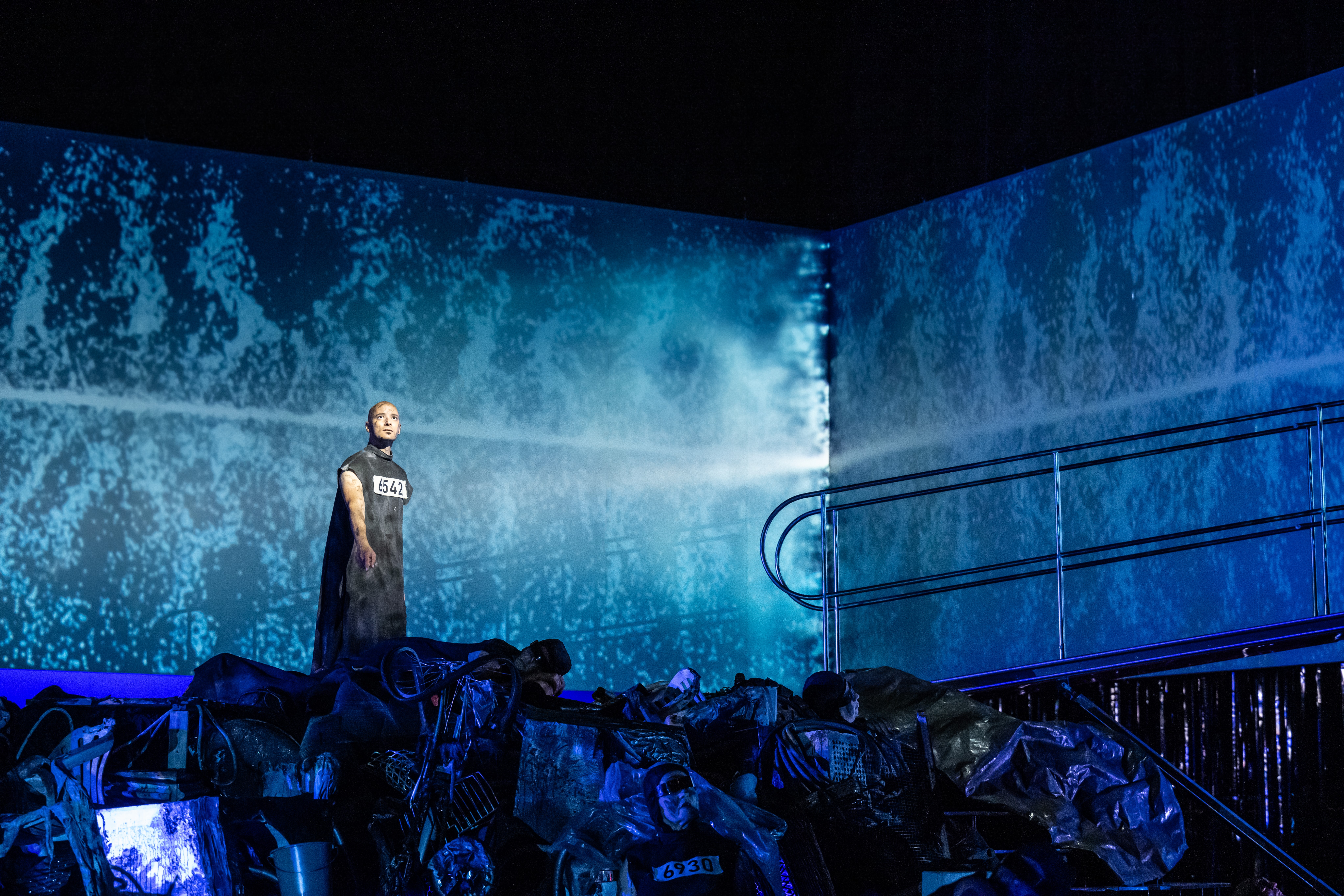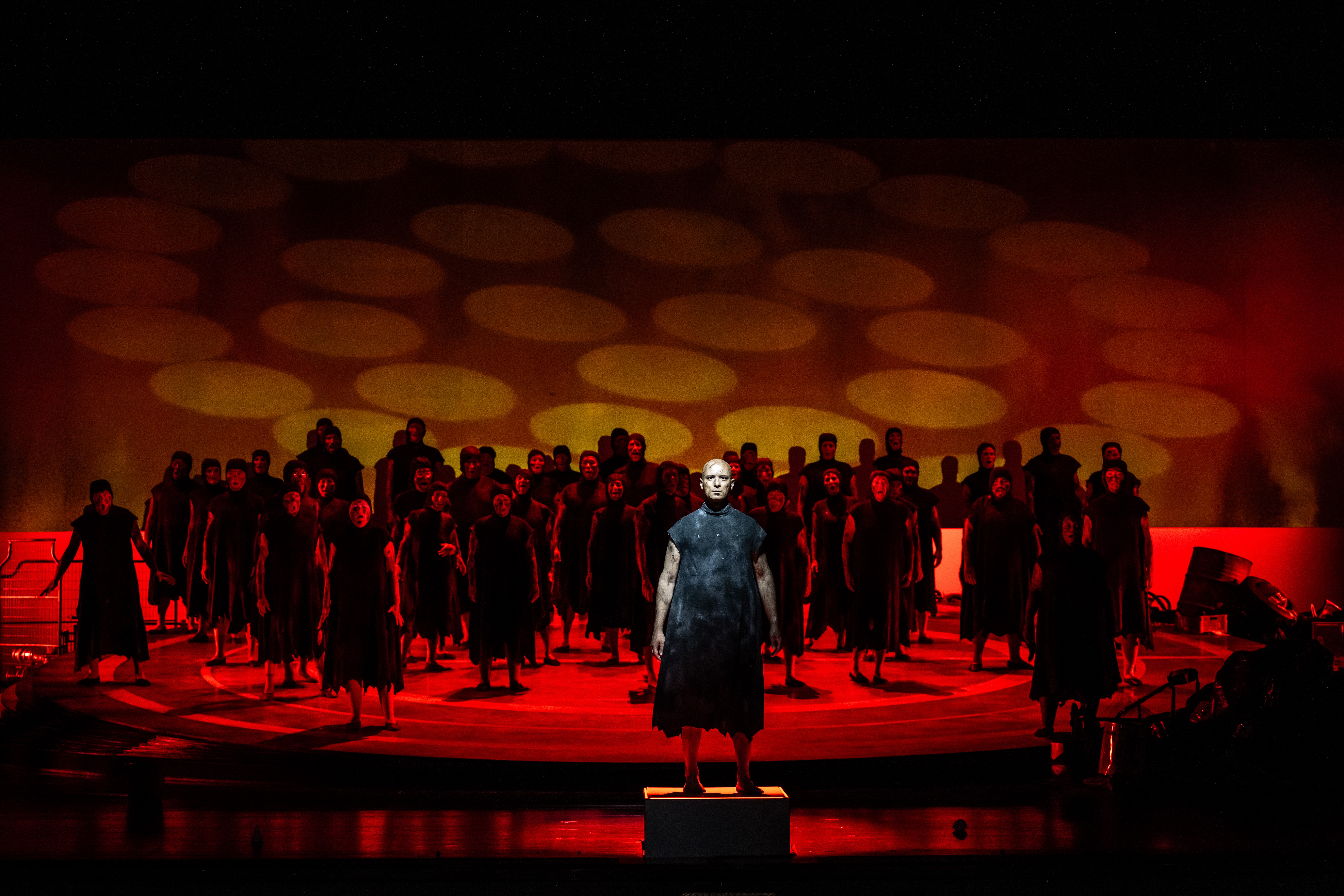Season opening at the Hanover State Opera: Daniel Kramer‘s acclaimed new production of Philip Glass’ peace opera sheds light on Mahatma Gandhi’s future viability. The stage and cast impress with the finest interpretation down to the smallest details.
War and peace, upheaval or resistance: ‘Satyagraha’, which means ‘loyalty to the truth’, laid the foundation stone for Gandhi’s freedom movement in South Africa, which, as is well known, ultimately led to India’s independence from British colonial rule through civil disobedience and non-violent resistance.
In his opera, which premiered in 1980 and forms the so-called portrait trilogy with ‘Einstein on the beach’ and ‘Akhnaten’ about the ancient Egyptian heretic pharaoh Akhenaten, Philipp Glass took on the early work of the freedom fighter who was murdered in 1948.
The work is much more than a chronological sequence and depiction of Gandhi’s work: the libretto in ancient Indian Sanskrit already clearly establishes the basis of the ‘Bhagavad Gita’, the scripture from the mythical national epic ‘Mahabharatha’ that founded Hinduism. This opera is thus a religious mystery play that seeks to fathom the essence and original reason for the being of Gandhi’s work beyond space and time. And this can only be done without the chronological sequence of scenes from Gandhi’s life. Glass’ “Satyagraha” thus also presents itself as a detached further development of a “stage consecration festival”. With his continued and even more rigorous reduction of stylistic devices, which Richard Wagner also used in his ‘Parsifal’ as a means to an end of any kind of religiosity, Glass succeeds simply and directly in creating a meditation piece with a strong pull.
The discontinuity of the chronology is supported not only by the mantra-like and spiritually undulating ‘minimalistic music’ without brass and percussion, but also by the naming of the three acts after Gandhi’s role models. Leo Tolstoy, Rabindranath Tagore and Martin Luther King are the sources of meaning for the individual acts, which does not prevent the American director Daniel Kramer from developing his directorial idea independently of the big names.

Great cinema films such as ‘2001 – A Space Odyssey’ also take place beyond infinity: Kramer varies the Gandhi ideology across the acts into the future and beyond the Earth in space. In Justin Nardella ‘s set, Gandhi, Krishna and Arjuna float into the stage from above at the beginning of the first act to discuss the pros and cons of violent resistance. Arjuna (Darwin Prakash with a flowing baritone) is all warmonger with red devil horns and a golden Kalashnikov rifle, which at first appears like a hippie guitar from the days of the 1968s with an Indian connection (costumes by Shalva Nikvashvili). Krishna brings peacemaking plastic flowers (Markus Suihonen with a round bass), but flower power is no more: in the background, the choir and videos (Chris Kondek) thematise the eternal return of the same wars, and Gandhi is shot. ‘Gandhi assassinated’ is emblazoned across the stage in huge letters, while Gandhi is mourned on his bier. This is followed by the first reincarnation of Satyagraha in the fluffy design of the Jungle Book at the time of British rule in India. But the paradisiacal conditions surrounding the cute cuddly animals around the black panther Bagheera & co., brought by the chorus, are only a sham: after all, the author of The Jungle Book, Rudyard Kipling, was a colonialist through and through. The director shows these ambiguities with a wink and a tear. The jungle book image becomes a picture of all kinds of drug mushrooms, which were very popular in those hippie days.
In the second act, civilisation is almost at an end. The year is 2048, and in the midst of huge piles of rubbish, a society held out by promises of salvation languishes in the hope of redemption. Wonderfully sanctimonious, the false preachers appear in white revivalist garb with halos and use the hashtags #sustainable, #yourfuture, #the_solution and #bonvoyage (projected in letters onto the background) to trick the congregation into believing they have found a remedy. Greenwashing sends its regards: while promising water dispensers are being handed out, the preachers of salvation themselves are already preparing to go to the moon. Gandhi’s red-haired wife Kasturbai dares to rebel and is shot dead. Beatriz Miranda plays and sings this with great intensity and a warm, flowing mezzo.

The dystopia is taken to its logical conclusion in the third act: the video shows a final flight over the earth in the year 3048. It is a primeval state without people, which now shows the beginning again beyond infinity, somewhere in the middle of nowhere. In front of cell division videos, velvety amoebas in three plush colours emerge from the stage and fraternise. It borders on kitsch, and Gandhi makes an appearance. The background opens up a view into the technology of the stage area, while the auditorium is illuminated.
Is Gandhi now fit for the future? With the ending to meditation music, the director does not provide a clear answer either. Gandhi thus hands over a rather indecisive handbook of action to the people. What follows can only be the eternal return of the same. A way out looks different. Daniel Kramer’s approach is nevertheless a response to the criticism levelled at the composer that his opera propagates a naïve theory of peace. And although many small details of the production clearly state his position, the pressing question of ‘war’ or ‘peace’ remains unanswered in the end.
In the leading role of Gandhi, Shanul Sharma impresses with his authentic acting and nuanced, variable and fitting expressiveness. His tenor sometimes flows appropriately pale, then he knows how to switch to dramatic, expansive intonation in order to score points in tender, meditative passages.

The choir, rehearsed by Lorenzo Da Rio, sings and acts with nuance and precision. Masaru Kumakura guides the Hanover State Orchestra attentively and clearly through the mantra-music tapestry, which is not at all simple and monotonous, but has a special effect thanks to the variations and reversals, doublings and delays. Only in the harmonisation with the choir would one have wished for a little more precision at times.
In the end, all those involved are applauded for this particularly successful season opener, which is extremely well-crafted and well thought out down to the smallest detail.